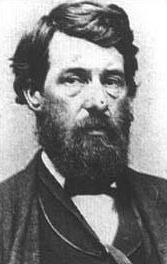George N. Barnard (George N. Barnard)

Photographer. He was born in Coventry, Connecticut, and opened his first daguerreotype gallery in Oswego, New York, in 1843. After years of practice with portraiture and landscapes, in 1853 he took 2 landmark images, shots of a gigantic Oswego mill fire, that were among the world’s first news photographs. After moving his studios to Syracuse in 1854, he switched to collodion wet-plate photography and took his darkroom on the road until 1862, when he joined photographic entrepreneur Mathew Brady and his “photographic corps” to record the Civil War. For Brady he shot an historic series of images of the battlefields from the First Bull Run Campaign and also took pictures of ruins in the Virginia countryside, of soldiers in camp and of the aftermath of the Union’s Siege of Yorktown. In these views individuals, buildings, trees, shattered cannon, and ruins were incorporated into broad composites implying the action that had taken place. His compositions required imagination from the viewer, a quality that became his trademark. His stay with Brady was brief, and in 1863 he was in Tennessee working independently on breathtaking shots of the river valleys and mountain country of the border South. Much of this scenery, never photographed before, was impressive to Eastern viewers and included the sites of the Battle of Lookout Mountain, Chattanooga, and other Tennessee fights, vistas that incorporated great natural beauty with historic interest. His next subject would be his most important contribution to Civil War photography. When Major General William T. Sherman’s campaign for Atlanta began, he reportedly followed the army and, immediately after the war, started his best remembered work. He made plates of almost all the Army of Tennessee’s battlefields, from the Volunteer State to the Atlanta city limits, and he was contracted by the United States government late in 1863 to photograph the Confederates’ Atlanta defenses and fortifications; he then continued on to Savannah and the Carolinas. His photos turned out to be landmark work. He went next to New York City, where in 1866 he produced Photographic Views of Sherman’s Campaign, a $100 book made up of 61 full size contact prints of his best work from previous years, which established his reputation as photographic historian and artist. His remaining years were spent in Chicago, (where he shot the destruction caused by the great fire, which also destroyed his studio), the Deep South, and elsewhere in the Midwest, keeping at the photographer’s art. He worked briefly with photographic pioneer George Eastman, and the Eastman Kodak Company as a demonstrator to promote their dry-plate process. In 1884 he moved to Painesville, Ohio, where he opened a studio and dry-plate manufactory with Horace W. Tibbals. In 1888 he and his family moved to Gadsden, Alabama, then in the early 1890s north again to a family farm in Cedarvale, New York, near Syracuse, where he would spend his remaining years, still taking photographs of area residents. He later would died there during a heavy snowstorm. Not a boastful man during his lifetime, his tombstone says what he dare wouldn’t, “Pioneer in Photography.” His work can be found today in the National Archives and the Library of Congress. (bio by: Ugaalltheway) Family links: Spouse: Sarah Jane Hodges Barnard (1823 – 1884)* Children: Mary Grace Barnard Gilbert (1848 – 1926)* *Calculated relationship
Born
- December, 23, 1819
Died
- February, 02, 1902
- USA
Cemetery
- Gilbert Cemetery
- USA

